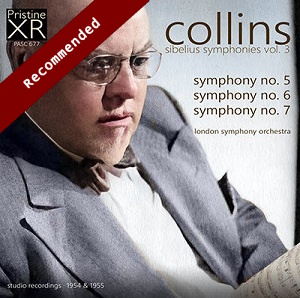
Jean Sibelius (1865-1957)
Symphony No 5 in E-flat major, Op 82
Symphony No 6 in D minor, Op 104
Symphony No 7 in C major, Op. 105*
London Symphony Orchestra/Anthony Collins
rec. 1954* & 1955, Kingsway Hall, London, UK
Ambient Stereo
Pristine Audio PASC677 [78]
This completes Pristine’s XR Remastering of Anthony Collins’ recordings of Sibelius’ symphonies into Ambient Stereo; I positively reviewed volume 1 in this series, so am pleased to see this well-filled trio appear, especially as, in common with many listeners I would guess, nos. 5 and 7 are my favourites. In those Fifth and Seventh Symphonies, Collins’ approach is, as before, generally fast and driven at thirty and twenty minutes respectively; his tempi for the Sixth are more conventional, resulting in a timing of 29 minutes, but its more lyrical, insouciant character requires a lighter hand and less insistence upon overt drama.
As before, there is some slight residual hiss but otherwise the remastering has resulted in there being a much-enhanced depth to the sound and a real sense of space around the instruments, making it virtually indistinguishable from early stereo. The opening is suffused with tension and wonder, the timpani coming through ominously and every instrument clearly delineated. It is remarkable how much menace Sibelius generates while remaining in major keys throughout this symphony but Collins’ urgency greatly facilitates that effect. The crescendo beginning around four minutes in is thrilling and the sawing strings over the brooding bassoon sound like a swarm of enraged hornets; Collins’ command of the stretto instruction is masterly. The great, rocking climax at 7:30 before the “sleigh ride” – or is it a wedding dance? – with its chirruping woodwind is exhilarating; the coda is breath-taking. Everything here is right and seems to make the thirteen-minute movement flash by.
The folksy charm of the Andante mosso is again tempered by Collins’ ability to give the music an inner tension, but the lyrical theme beginning at three minutes in, underpinned by whooping horns, is as affectionate as the opening of the first movement is monitory. Once again, too, Collins demonstrates his feeling for managing and gauging a gradual accelerando over a broad span, then the pizzicato section ushers in the consolatory ending, where he relaxes deliciously.
After such riches, only the most electrifying Allegro molto finale will do – and Collins delivers. As with his previous approach to earlier symphonies, I can understand that some listeners would prefer a more spacious manner but there is no denying the homogeneity of Collins’ vision of how this symphony should progress. The LSO strings play out of their skins, too. That famous pounding conclusion is supremely satisfying, the pauses perfectly gauged.
It is such a switch of mood to the yearning opening of the Sixth, achingly beautiful with the stern bass and timpani underlay coming through tellingly. Once again we hear fluid, fluent playing from the LSO of remarkable crispness and unity, especially in the scurrying, skipping Presto. I always feel that the finale is something of an assemblage of Sibelian tropes, which provides an opportunity to a conductor to demonstrate how at ease he or she is in playing them idiomatically – and of course Collins triumphantly succeeds, as one novel idea succeeds another. The symphony as a whole may be less undisguisedly demonstrative than the Fifth but the finale tugs determinedly at the heart strings, never quite finding the still point of repose and concluding on the “dying fall” of the prolonged diminuendo D.
The Seventh is up against some stiff competition in the catalogue. There is noticeably more background hiss here and a somewhat more distant aural perspective which first militate against the creation of the oddly ambiguous mood and sumptuous sound which characterise versions by such as Karajan on DG and Ormandy on Sony. That is a passing objection, however, given Collins’ gift for maintaining concentration over a wide span; the whirling winds and blaring brass beginning exactly half-way through herald a long arc of melody and momentum towards one of the most satisfying climaxes in symphonic music, prolonged and sustained over the last four minutes of this movement and superbly delivered here.
Once again, the cover photograph depicts the conductor glowering; I am sure he would smile if he could hear what Andrew Rose has done for his recordings here.
Ralph Moore
Availability: Pristine Classical

















